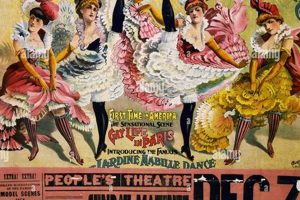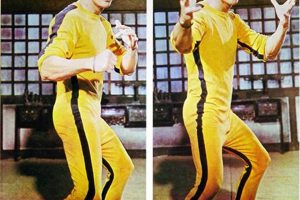Original promotional artwork for the James Bond film franchise, created during the initial theatrical release of each movie, constitutes a highly sought-after category of collectible movie memorabilia. These items, often featuring iconic imagery and distinctive design aesthetics reflective of their respective eras, represent tangible connections to the cinematic history of the world’s longest-running spy series. For instance, a poster promoting the 1964 film Goldfinger, designed by Robert Brownjohn, showcases the film’s themes and characters, capturing the visual style prevalent during that period.
The importance of these artifacts extends beyond their decorative appeal. They offer valuable insight into the marketing strategies employed to promote the films, the cultural context in which they were released, and the evolving image of the James Bond character. Further, the value of these items can appreciate significantly over time, making them attractive investments for collectors. The historical significance lies in their reflection of evolving artistic styles, printing techniques, and the popular perception of espionage during the Cold War and beyond.
Understanding the characteristics, valuation, and preservation of these artifacts is essential for both seasoned collectors and those new to the world of movie memorabilia. This will assist in navigating the market and ensuring the longevity of valuable pieces of cinematic history.
Essential Considerations for Collectors
Navigating the market for original James Bond promotional artwork requires careful consideration and informed decision-making. The following guidance aims to assist collectors in acquiring authentic pieces and maintaining their value.
Tip 1: Authentication is Paramount: Verify the authenticity of the item through reputable dealers and expert appraisal services. Scrutinize the printing techniques, paper stock, and any studio markings to ensure originality. Counterfeit items are prevalent; thorough diligence is essential.
Tip 2: Condition Significantly Impacts Value: Assess the physical condition meticulously. Tears, folds, stains, and fading can significantly diminish the item’s worth. Seek items in the best possible condition that aligns with budgetary constraints.
Tip 3: Understand the Rarity Factor: Certain designs or variations produced in limited quantities command higher prices. Research the print runs and distribution methods to determine the scarcity of a specific design. Regional variations or promotional items distributed exclusively to cinemas often hold greater value.
Tip 4: Research Auction Records: Examine past auction results from reputable auction houses to establish a baseline for valuation. Monitor the price fluctuations and trends within the market to inform bidding strategies.
Tip 5: Proper Storage is Crucial: Protect the investment through appropriate storage methods. Employ acid-free materials for backing and encapsulation. Control the environment to minimize exposure to light, humidity, and temperature fluctuations. Professional archival framing offers optimal protection.
Tip 6: Document Provenance: Maintain a clear record of the item’s history, including purchase details, dealer information, and any relevant documentation establishing its ownership lineage. Provenance enhances the item’s credibility and potential resale value.
Tip 7: Specialize and Focus: Concentrating on a particular era, artist, or film can foster a deeper understanding of the market and enable more informed acquisitions. Specialization allows for targeted research and potentially uncovering undervalued pieces.
Adhering to these guidelines can mitigate risks, maximize investment potential, and ensure the long-term preservation of these significant pieces of cinematic art.
Building upon these considerations, the subsequent sections will explore the aesthetic appeal and design elements that characterize significant examples of promotional material.
1. Artwork Styles
The aesthetic diversity present in original promotional materials significantly shapes the identity and desirability of these collectible items. The evolution of graphic design trends, coupled with the specific artistic vision employed for each film, results in a wide range of styles that appeal to diverse collectors and reflect the changing cultural landscape.
- Mid-Century Modernism
Characterized by bold geometric shapes, minimalist compositions, and vibrant color palettes, this style, prevalent in the 1960s, is exemplified by Robert Brownjohn’s work on Goldfinger. The clean lines and striking visual impact align with the era’s emphasis on modernity and technological advancement, mirroring the sophisticated image of James Bond.
- Illustrative Realism
Employed frequently throughout the 1970s and 1980s, this style features detailed and realistic depictions of actors and scenes from the films. Artists like Robert McGinnis, known for his work on Diamonds Are Forever and Live and Let Die, captured the glamour and action of the franchise through meticulously rendered illustrations. This style aimed to convey a sense of authenticity and excitement, drawing audiences into the world of espionage.
- Photographic Montage
This approach combines photographic imagery with graphic design elements to create dynamic and visually arresting compositions. Posters utilizing this style often feature a collage of key characters, vehicles, and action sequences. The montage technique aims to encapsulate the multifaceted nature of the Bond films, highlighting the action, intrigue, and glamorous lifestyle associated with the franchise.
- Abstract and Stylized Design
Some examples deviate from realism, embracing abstract forms and stylized representations of characters and themes. These designs often prioritize visual impact and artistic expression over literal depiction. While less common, these represent distinct deviations in marketing strategies and offer a unique aesthetic perspective on the franchise.
These diverse artistic approaches contribute significantly to the allure of original promotional material. The stylistic variations not only reflect the evolving aesthetic preferences of each era but also offer collectors a diverse range of options to pursue, based on individual tastes and investment strategies. Understanding the nuances of each style is essential for appreciating the artistic value and historical significance of these artifacts.
2. Rarity Factors
Scarcity significantly dictates the value and collectibility of original James Bond film promotional material. The factors contributing to the scarcity of a particular item are diverse and complex, encompassing production quantities, distribution methods, and historical circumstances.
- Limited Print Runs
The initial number of posters produced for a film’s release directly impacts its current rarity. If a studio printed a smaller quantity, the surviving examples become more desirable. For instance, preliminary or advance releases often had shorter print runs compared to the general release posters, contributing to their increased value.
- Regional Variations
Different countries often commissioned unique poster designs or utilized alternative printing techniques. A design specific to a particular geographic region can command a premium due to its limited distribution. Examples include British Quad posters or Japanese B2 posters, which feature distinct artwork compared to their American counterparts.
- Studio Archives and Promotional Items
Material originating directly from the film studio or distributed exclusively to cinemas or industry insiders tends to be rarer. These items may include press kits, lobby cards, or specialized promotional posters not available to the general public. Their restricted availability makes them highly sought after by collectors.
- Survival Rate and Condition
The number of original items that have survived over time, and their condition, significantly influences scarcity. Environmental factors, improper storage, and accidental damage diminish the pool of available examples. A poster in excellent condition from a limited print run will be considerably rarer, and thus more valuable, than a damaged or heavily worn example.
Understanding these contributing factors enables a more nuanced assessment of a poster’s rarity. Collectors must consider these variables when evaluating potential acquisitions. Rarity, combined with artistic merit and historical significance, determines the overall value and desirability within the market for original James Bond film promotional material.
3. Condition Assessment
The evaluation of physical condition is a critical determinant of value for original promotional material. The presence and severity of imperfections directly impact a poster’s desirability and market price. A standardized system for assessing condition is essential for both buyers and sellers to accurately represent the item’s state and establish a fair market value.
- Paper Quality and Integrity
Original James Bond film releases utilized varying paper stocks, each susceptible to degradation over time. Brittle paper can exhibit tears, creasing, and chipping along the edges. The presence of acid migration from improper storage can result in discoloration and weakening of the paper fibers. The paper’s original characteristics and current structural integrity are fundamental indicators of condition.
- Color Fading and Image Integrity
Prolonged exposure to light, particularly ultraviolet radiation, can cause significant fading of inks and dyes. Assessing the vibrancy and accuracy of the original colors is essential. Any discoloration, color shift, or loss of image detail detracts from the poster’s aesthetic appeal and market value. Additionally, damage from moisture or chemical exposure can cause staining or image distortion.
- Physical Imperfections and Restoration
Tears, pinholes, fold lines, and other physical imperfections are common in vintage items. The size, location, and severity of these flaws are considered during the evaluation. Professional restoration can mitigate some damage, but the extent and quality of the restoration influence the poster’s overall value. Over-restoration can detract from the authenticity and potentially decrease the item’s worth.
- Mounting and Display Damage
Previous mounting methods, such as glue, tape, or framing, can leave irreversible damage. Residue from adhesives, impressions from framing hardware, and staining from backing materials are common issues. These marks detract from the poster’s visual presentation and can compromise its long-term preservation.
A comprehensive condition assessment considers these factors to determine the overall grade of a vintage poster. Standardized grading systems, such as those used by professional grading services, provide a framework for objectively evaluating condition. This assessment is vital for establishing a fair price, ensuring transparency in transactions, and guiding appropriate preservation strategies for valuable pieces of cinematic history.
4. Authentication Process
The verification of originality constitutes a critical step in acquiring vintage James Bond film promotional material. Due to the inherent value and desirability of these collectibles, the market is susceptible to forgeries and reproductions. A rigorous authentication process is therefore essential to protect the interests of collectors and ensure the integrity of the market.
- Paper Stock Analysis
Examination of the paper type used in the printing process is a fundamental aspect of authentication. The paper stock employed for original posters often differs significantly from modern printing materials. Identifying the paper’s composition, weight, and texture, and comparing it to known authentic examples, can reveal inconsistencies indicative of a reproduction. For instance, examining the paper fiber under magnification may reveal the presence of wood pulp in modern reproductions, while originals may utilize higher-quality, acid-free paper.
- Printing Technique Verification
The printing methods employed during the original release period of a film can serve as a reliable indicator of authenticity. Identifying the specific printing technique, such as lithography, offset printing, or silkscreen, and comparing it to the techniques used for reproductions, can reveal discrepancies. The presence of a dot matrix pattern, often indicative of modern digital printing, would immediately raise concerns about the item’s originality. High-resolution imagery and expert analysis are necessary for this verification.
- Studio Markings and Copyright Notices
Original promotional material typically includes studio logos, copyright notices, and printer’s marks. Verifying the presence, placement, and accuracy of these markings is crucial. Discrepancies in font styles, logo designs, or the absence of copyright information can indicate a reproduction. Comparison with known authentic examples and consultation with experts in the field are essential for accurate assessment.
- Black Light Examination
Utilizing ultraviolet (UV) light can reveal subtle inconsistencies not visible under normal lighting conditions. Modern inks and paper may fluoresce under UV light, while older materials may exhibit a dull or muted response. This method can detect the presence of recent repairs or alterations, as well as identify reproductions printed using modern inks. Black light examination serves as a supplementary tool in the authentication process.
The application of these authentication methods requires specialized knowledge and expertise. Engaging reputable dealers, consulting with experienced collectors, and utilizing the services of professional authentication companies can significantly mitigate the risk of acquiring a non-authentic item. The authentication process is an ongoing effort, requiring continuous learning and adaptation to new techniques and emerging forgeries. Thorough due diligence remains paramount in the acquisition of valuable vintage James Bond film promotional material.
5. Historical Context
Understanding the historical context surrounding these original promotional materials is crucial for appreciating their significance and value. The posters serve not merely as advertisements but as cultural artifacts reflecting the socio-political climate, artistic trends, and evolving perceptions of espionage during their respective eras.
- The Cold War and Espionage
The James Bond film franchise emerged and flourished during the Cold War, a period characterized by heightened international tensions and pervasive anxieties about espionage and nuclear conflict. The initial posters often capitalized on these anxieties, portraying Bond as a symbol of Western resilience and ingenuity in the face of Soviet threats. Imagery frequently included suggestive motifs of nuclear weaponry and covert operations, mirroring the contemporary geopolitical landscape.
- Evolving Gender Roles and Representation
The portrayal of women in promotional imagery reflects the shifting gender dynamics of the 1960s through the 1980s. Early posters often featured women in stereotypical roles as damsels in distress or femme fatales. However, as societal attitudes evolved, later posters began to depict female characters in more empowered and independent roles, reflecting the broader feminist movement. Examining this evolution reveals valuable insights into changing cultural attitudes toward gender representation.
- Technological Advancements and Futuristic Visions
The franchise consistently incorporated cutting-edge technology and futuristic gadgets, reflecting contemporary fascination with scientific progress. Posters frequently showcased these technological marvels, from jetpacks and underwater vehicles to laser weapons and satellite communication systems. Analyzing these depictions provides insights into the era’s technological aspirations and anxieties.
- Film Marketing Strategies and Design Trends
The design styles employed in promotional material mirrored the prevailing graphic design trends of each decade. The bold, geometric designs of the 1960s contrasted with the illustrative realism of the 1970s and 1980s. These stylistic shifts reflected evolving marketing strategies and the changing preferences of target audiences. Analyzing these design elements provides insight into the broader history of film marketing and visual communication.
By examining these diverse historical facets, a deeper appreciation emerges for vintage original promotional material. These artifacts function as tangible representations of specific historical moments, capturing the cultural anxieties, technological aspirations, and evolving social norms of their time. The historical context, therefore, is not merely a backdrop but an integral element of their value and significance as cultural objects.
6. Investment Value
The increasing financial value attached to vintage original James Bond film promotional material stems from a confluence of factors. The enduring popularity of the franchise, coupled with the limited availability of original posters, creates a dynamic marketplace where demand frequently outstrips supply. Investment potential is significantly influenced by factors such as the film’s commercial success, the iconic status of its imagery, the rarity of specific designs, and the overall condition of the item. For example, a first-release British Quad poster for Dr. No in excellent condition can command prices considerably exceeding that of later re-releases or posters in poor condition. This disparity highlights the importance of provenance, condition, and scarcity as drivers of investment value.
Market analysis reveals a consistent upward trend in the value of certain posters, particularly those from the early Bond films and those featuring artwork by renowned illustrators. The collector base extends beyond dedicated film enthusiasts, attracting art collectors, design aficionados, and investors seeking alternative asset classes. The relative stability of the market, coupled with the tangible nature of the asset, offers a degree of protection against broader economic fluctuations. Furthermore, the international appeal of the Bond franchise ensures a global market for these collectibles, increasing liquidity and potential for appreciation. Successful investment necessitates thorough research, expert appraisal, and strategic acquisition, as not all items possess equal potential for financial return. Careful consideration of condition, rarity, and historical significance is paramount.
In conclusion, the investment value associated with vintage original James Bond film promotional material is directly linked to the inherent characteristics of the items themselves, the dynamics of the collector market, and the broader economic landscape. While potential returns can be substantial, successful investment demands a nuanced understanding of the market, a commitment to due diligence, and a long-term perspective. The challenges lie in authenticating items, assessing condition accurately, and navigating a market susceptible to speculation and fluctuating demand. Nevertheless, the convergence of cinematic history, artistic merit, and enduring popularity continues to drive the value of these collectibles as alternative investment assets.
7. Preservation Methods
The long-term preservation of original promotional material is vital for maintaining its aesthetic appeal, historical significance, and investment value. Proper preservation techniques mitigate the effects of environmental factors, handling damage, and inherent material degradation, ensuring that these artifacts endure for future generations. Applying appropriate methods requires understanding the inherent vulnerabilities of paper-based collectibles and implementing strategies to minimize risks.
- Archival Storage
Storage within archival-quality materials constitutes a cornerstone of preservation. Acid-free folders, sleeves, and boxes prevent chemical migration from the storage materials to the artwork. Encapsulation within inert polyester film provides physical protection without introducing harmful chemicals. Climate-controlled environments minimize fluctuations in temperature and humidity, mitigating the risk of paper degradation, mold growth, and pest infestations. Specific recommendations include storing posters flat whenever possible, avoiding direct sunlight, and maintaining a stable temperature between 65-70F with relative humidity between 45-55%.
- Handling Protocols
Safe handling procedures minimize physical damage during examination, display, or relocation. Clean, lint-free cotton gloves prevent the transfer of oils and dirt from hands to the poster’s surface. Support the entire poster when moving it to avoid bending or creasing. Avoid using sharp objects near the poster and refrain from writing directly on its surface. Rolling posters for transport or storage should be done with archival-quality interleaving paper to prevent abrasion. Training in proper handling techniques is essential for individuals involved in the care and management of these collectibles.
- Professional Framing
Framing provides both protection and display capabilities, but improper framing can cause irreversible damage. Employing a qualified framer experienced in archival techniques is crucial. Acid-free matting and backing boards prevent chemical migration, while UV-filtering glazing minimizes light damage. Spacers between the artwork and the glazing prevent condensation and adhesion. Reversible mounting methods, such as linen tape hinges, allow for future removal without damaging the poster. Avoid using acidic tapes, glues, or pressure-sensitive adhesives, as these can cause permanent staining and deterioration.
- Restoration and Conservation
Professional restoration and conservation can address existing damage and stabilize the poster’s condition. Trained conservators employ specialized techniques to repair tears, remove stains, flatten creases, and reinforce weakened areas. Restoration is undertaken only when necessary to stabilize the item and should be performed according to ethical conservation principles, prioritizing reversibility and minimal intervention. Comprehensive documentation of the restoration process is essential for maintaining provenance and transparency. Engaging a qualified conservator is a significant investment that can greatly extend the lifespan of valuable promotional items.
The consistent application of these preservation methods serves to safeguard the long-term integrity of original promotional material. By mitigating environmental risks, implementing safe handling protocols, employing archival framing techniques, and utilizing professional restoration services when needed, collectors and institutions can ensure that these pieces of cinematic history remain accessible and appreciated for generations to come. These concerted efforts enhance both the intrinsic cultural value and the economic worth of James Bond film posters.
Frequently Asked Questions Regarding Original James Bond Film Promotional Material
The following questions address common inquiries concerning the authentication, valuation, preservation, and acquisition of collectible James Bond film advertising material. Accurate information is crucial for navigating this specialized market and ensuring informed decision-making.
Question 1: How can the authenticity of a purported original be determined?
Authentication requires a multi-faceted approach, including detailed examination of the paper stock, printing techniques, studio markings, and copyright notices. Comparison with known authentic examples and consultation with experts are essential steps in verifying originality.
Question 2: What factors contribute to the valuation of vintage posters?
Valuation is influenced by a combination of factors, including the film’s commercial success, the poster’s design and artistic merit, its rarity based on printing quantities and regional variations, and its overall physical condition. Provenance also plays a role in establishing value.
Question 3: What constitutes acceptable condition for a collectible poster?
Condition assessment considers paper quality, color vibrancy, the presence of tears or creases, and any evidence of restoration. Collectors should prioritize items in the best possible condition that aligns with budgetary constraints, recognizing that condition significantly impacts value.
Question 4: What are the optimal methods for preserving film promotional material?
Preservation entails archival-quality storage using acid-free materials, controlled environmental conditions to minimize temperature and humidity fluctuations, proper handling protocols to prevent physical damage, and professional framing with UV-filtering glazing. Preventative measures are crucial for long-term preservation.
Question 5: What are common red flags indicating a reproduction or forgery?
Red flags include the use of modern paper stock, the presence of a dot matrix printing pattern, inconsistencies in studio markings or copyright notices, and fluorescence under ultraviolet light. Thorough inspection is essential to identify potential forgeries.
Question 6: How does one locate reputable dealers and appraisers in this specialized field?
Identifying reputable professionals involves seeking referrals from established collectors and institutions, verifying credentials and experience, and reviewing testimonials or references. Due diligence is essential to ensure reliable expertise and ethical practices.
Acquiring accurate knowledge and consulting with specialists can mitigate risks associated with collecting original James Bond film promotional material. Informed decisions protect investments and preserve these significant pieces of cinematic history.
Building upon these answers, the ensuing section will explore potential sources for acquiring valuable promotional materials.
Conclusion
The preceding exploration of vintage james bond posters has highlighted various facets, from authentication and condition assessment to historical context and investment potential. These elements underscore the complexity inherent in collecting and preserving such artifacts. The enduring popularity of the James Bond franchise, coupled with the scarcity of original promotional material, creates a unique market requiring informed decision-making.
The preservation and appreciation of vintage promotional artwork constitute a responsibility for both collectors and institutions. Careful stewardship ensures that these tangible pieces of cinematic history remain accessible for future generations, offering continued insight into the cultural and artistic landscape surrounding the James Bond legacy.







